
Pollensa, or Pollença in Catalan, is one of the most charming villages in Mallorca, situated in the north of the island. This picturesque place enjoys a privileged location, making it a perfect destination for a holiday in the Balearics. Just a few kilometres away, you’ll find its port, Port de Pollença, and some of the most outstanding beaches in the region. But Pollensa is not only famous for its beaches; it also offers stunning views and hiking trails in the majestic Sierra de Tramuntana mountains, a UNESCO World Heritage Site.
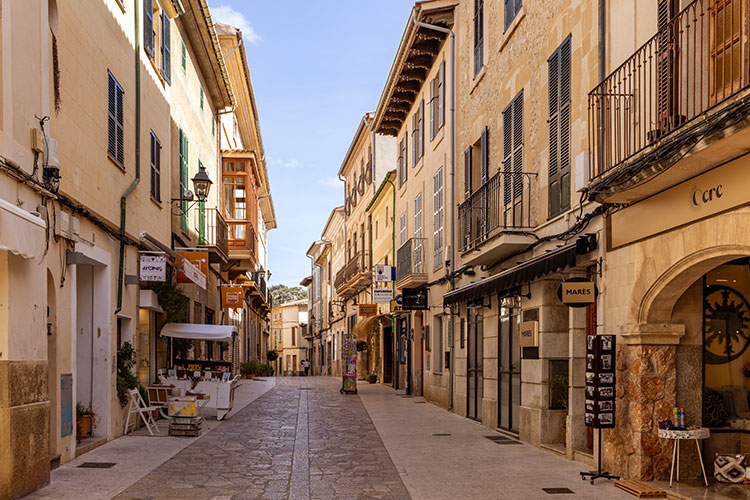
The Mediterranean landscape of Pollensa is enhanced by its narrow streets, stone houses, and squares lined with cafés, bars, and restaurants. Every corner of the town tells a story, reflecting its rich historical heritage. Despite being a popular tourist destination, Pollensa maintains a quiet and authentic atmosphere, far removed from the hustle and bustle of typical mass tourism resorts.
Pollensa History
Before Pollensa was founded, this area was already steeped in history. More than 3,000 years ago, during the pre-Talayotic period, structures called naviforms were constructed, and their remnants can still be observed today. Moreover, there is a cave necropolis in Cala Sant Vicenç, where ancient inhabitants rest in peace.
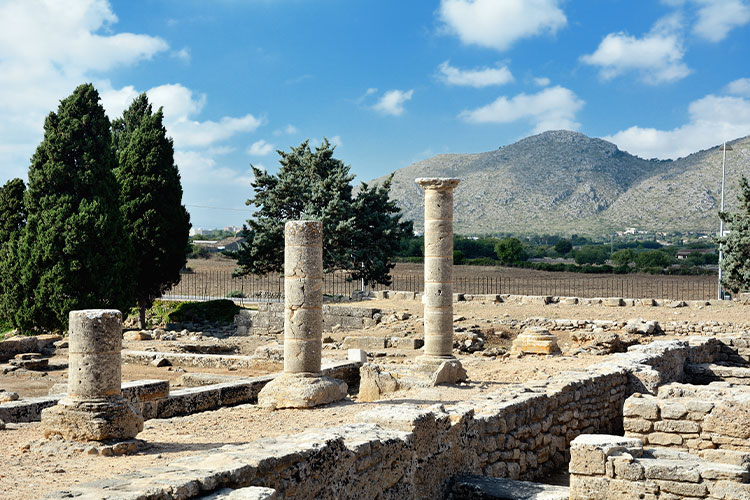
Then the Romans arrived, founding the city of Pollentia in the year 123… in Alcudia. Yes, not in Pollensa. You can still visit the remains of this Roman city, and it is a worthwhile excursion.
With the Arab conquest, the region was renamed Bullansa, which is like saying Pollentia in Arabic. But the real foundation of Pollensa took place after the Christian conquest in 1229, when King Jaume I distributed the land among Templars, bishops, and other nobles. Under the rule of the Templars, the town prospered. They built a church in the main square, Nostra Senyora dels Àngels.
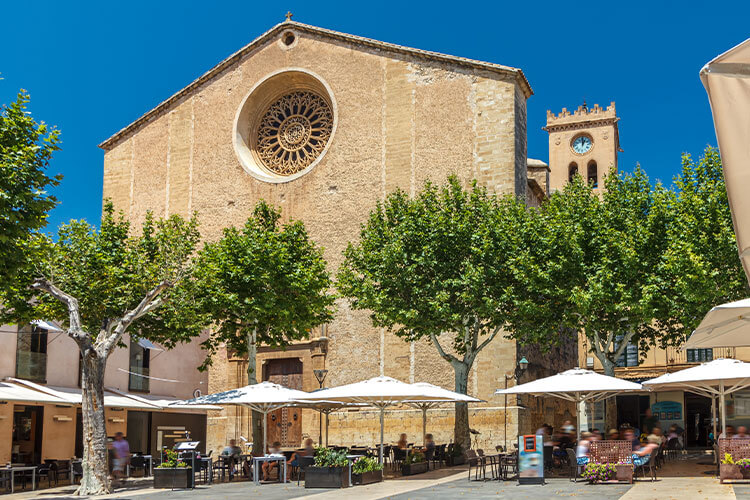
The Christian and Catalan influence is evident in the historic centre of Pollensa, particularly in its religious buildings. The Templars left the island for good in the 14th century, and the Jesuits took over, constructing the church of Monti-Sion in the 18th century.
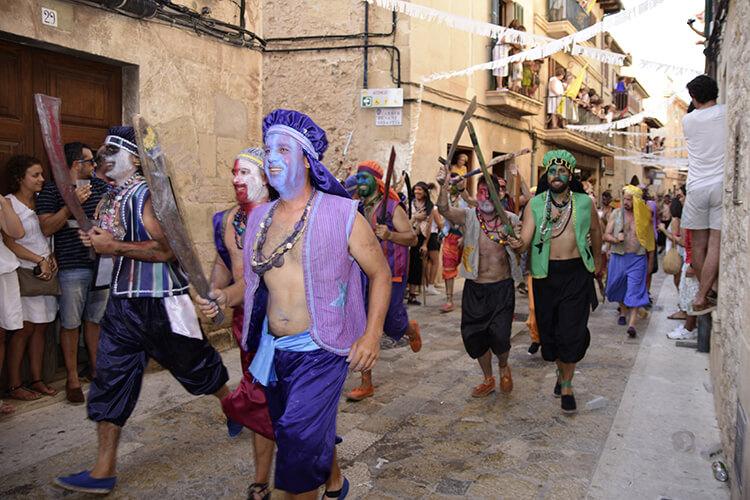
During the 15th and 16th centuries, this area of Mallorca was often attacked by pirates, with the most famous attack occurring in 1550 by the Moors. Local hero Joan Mas led a small group of courageous citizens who, armed only with sticks, successfully defeated the invaders. This brave act is commemorated annually on 2 August with a re-enactment of the battle. During the festival of Mare de Déu dels Àngels, the inhabitants dress up as Christians and Moors to celebrate this event.
Things to do in Pollensa
Pollensa offers a multitude of experiences that capture the authentic charm of this Mediterranean town. Below are the most remarkable places to explore during your visit to Pollensa.
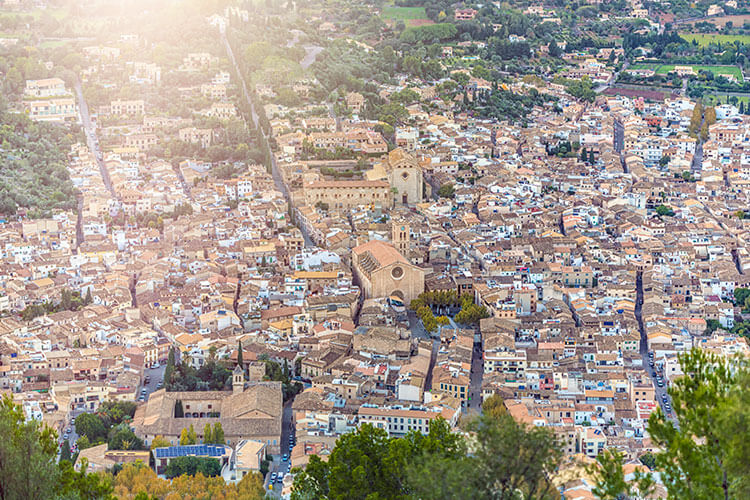
Plaza Mayor
If you take a stroll along Carrer Antoni Maura, you’ll come across the beating heart of Pollensa in a matter of minutes: the Plaza Mayor.
This square, built between 1854 and 1857, is not only a hub of activity but also a real spectacle for the senses. Why is that? Because every Sunday it is transformed into a lively street market overflowing with local produce. Here you can find fruit, vegetables, fresh fish, clothing and, of course, those irresistible souvenirs that always catch our eye.
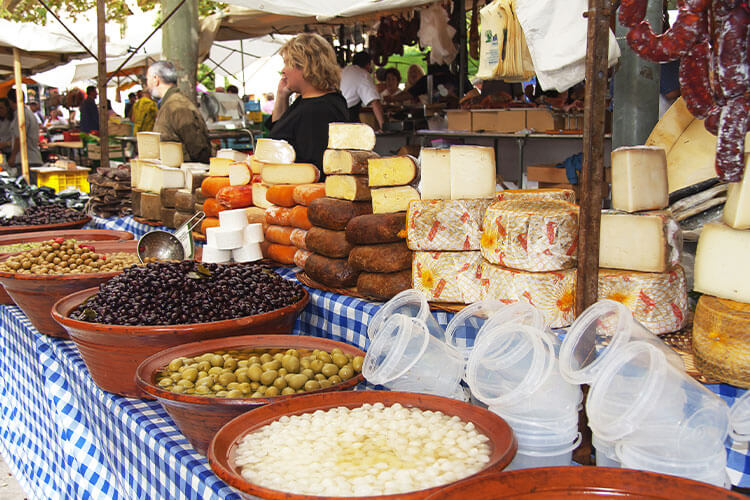
The impressive Parish Church of the Virgen de los Ángeles, the patron saint of Pollensa, is located in the Plaza Mayor. Founded in 1236 and later rebuilt between 1714 and 1790, the church still retains the original sections of the bell tower. Inside, visitors can admire a Baroque altarpiece dedicated to the Virgin of the Angels, as well as fourteen paintings depicting the Stations of the Cross, creating a serene and spiritual atmosphere.
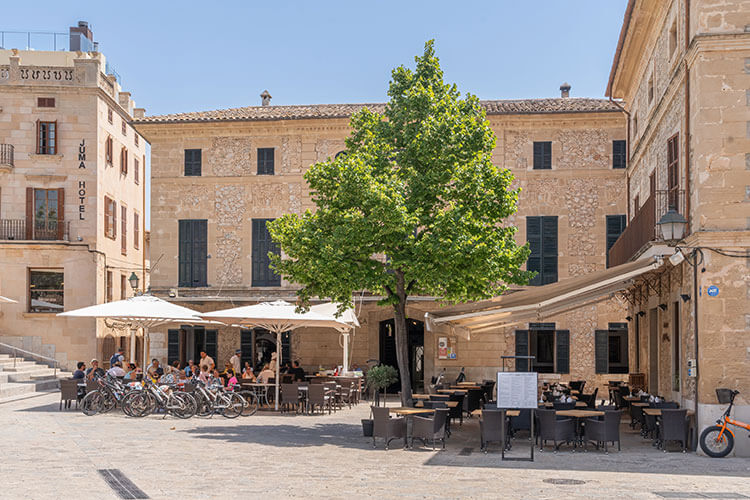
Fancy a break? Don’t worry, the terraces in the square are always at your disposal, offering the perfect place to relax with a coffee or a cold beer. Among the places to eat, Mon Restaurant stands out, known for its elaborate tapas. So, if you’re a lover of good food, this square has you covered.
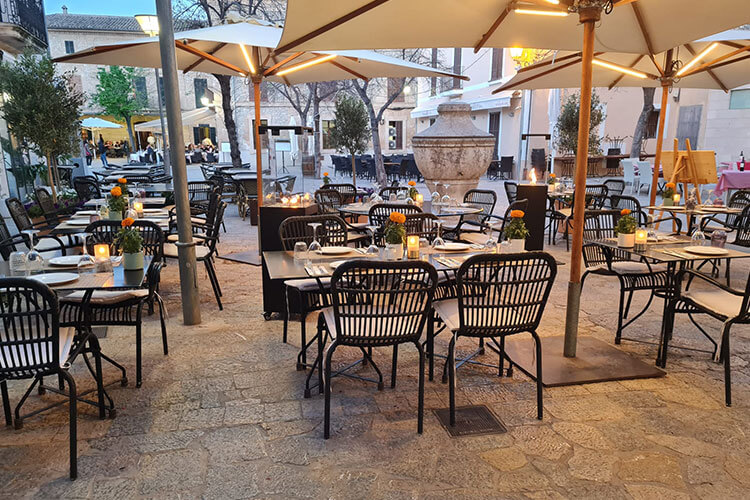
Since its construction, Plaza Mayor has become the social centre of Pollensa. In addition to the Sunday market, the square hosts several traditional festivities. For example, on 20th January, Saint Sebastian’s Day, the Els Cavallets dance is held, where two horse figures and a Roman centurion perform a traditional dance.
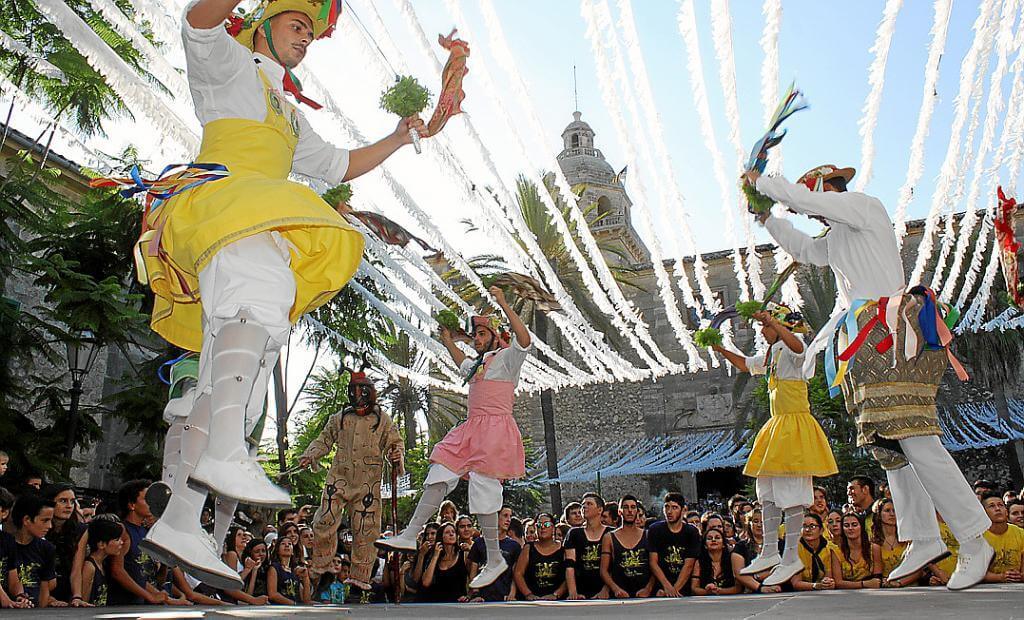
On 2nd August, during the Patron Saint’s Festival, you can enjoy the dance of Els Cossiers, an ancient medieval dance that symbolises the struggle between good and evil, although in Pollensa the figure of the devil does not appear as in other towns.
Claustro de Santo Domingo
The Convent of Santo Domingo, built between the 16th and 17th centuries by the Dominicans, is a must-see in Pollensa.
This majestic building is not only an architectural treasure but also a vibrant cultural centre that has hosted the famous Pollensa Music Festival since 1962. This festival, one of the most important in the world, is held in the convent’s impressive Baroque cloister, renowned for its excellent acoustics.
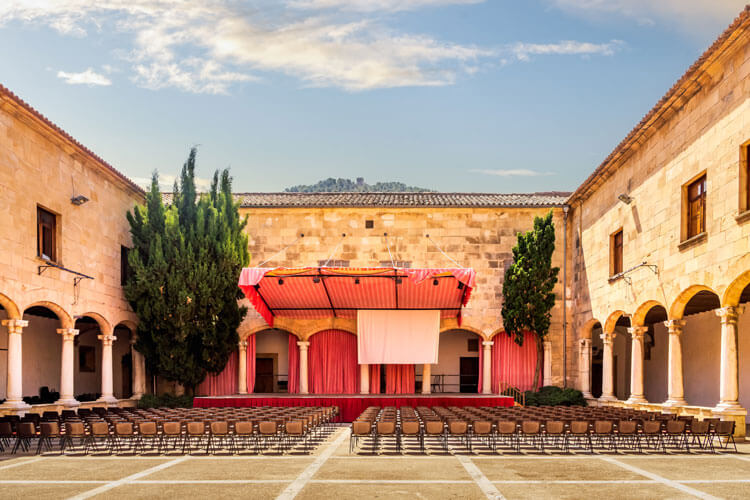
The convent church is basilica-shaped and features 10 side chapels adorned with beautiful altarpieces from the period. The main altarpiece, dedicated to the Virgin of the Rosary, is a masterpiece by the Mallorcan sculptor Joan Antoni Oms, created between 1651 and 1662. This image of the Virgin dates from the 15th century and comes from the Oratory of Roser Vell, adding a historical and spiritual touch to the place.
The convent also houses the Museum of Pollença, where you can admire a varied collection of paintings, archaeological pieces, and a Buddhist mandala. This cultural space has had multiple uses over the years, serving as a hospice residence, Civil Guard barracks, school and library, reflecting its importance in the local community.

If you visit Pollensa in spring, don’t miss the Pollensa Wine Fair, organised by the Associació Vi Primitiu de Pollensa. This event, held in the convent, attracts locals and connoisseurs alike, offering the chance to taste wines from dozens of vineyards for a small entrance fee. It’s a perfect occasion to enjoy local flavours in an unrivalled historic setting.
So, if you’re looking for a rich and diverse cultural experience, the Convent of Santo Domingo awaits you with open arms and a fascinating story to tell.
Jardines Joan March and Torre Desbrull
The Desbrull Tower, located in the Joan March Gardens, is a 14th-century Gothic jewel that belonged to the influential Desbrull family.
This historical monument stands out for its medieval window and a 16th-century cannon, which comes from the old watchtower at Punta dels Ferrers. The tower is a living example of Pollensa’s architectural heritage and offers a glimpse into the region’s medieval past.
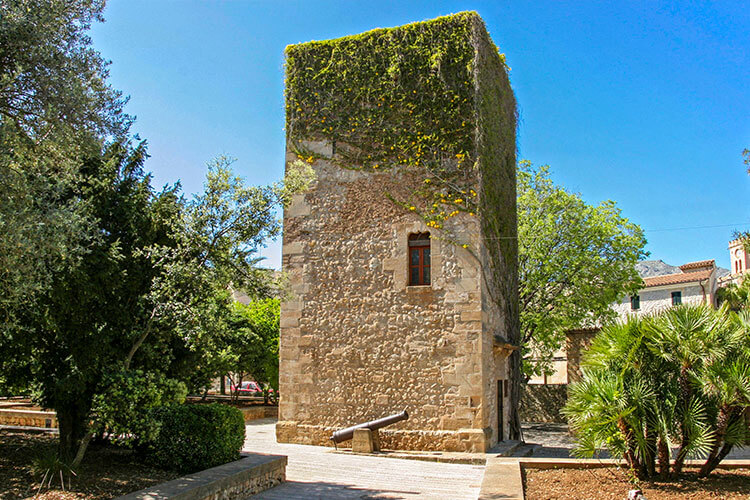
The Joan March gardens, situated next to the cloister of Santo Domingo, were donated by the March family, one of the best known on the island. Converted into a public park and botanical garden in the late 1980s, these gardens offer a peaceful setting full of history, ideal for a cultural visit to Pollensa. Here you will find rich native vegetation, including wild olive trees, yews, orange trees, carob trees, palmettos, and cypresses, providing shade and coolness during your walk.
In the same enclosure, you will find the statue of Joan Mas, a local hero who defended Pollensa from a pirate attack in 1550.
So, if you are looking for a place where history and nature intertwine, the Joan March Gardens and the Desbrull Tower are a magical corner that you cannot miss during your visit to Pollensa.
The Calvari
If you visit Pollensa, you can’t miss the opportunity to climb the famous 365 steps of the Calvario. Sound like “torture” to you? Well, don’t worry, the effort is worth every drop of sweat.
This iconic site challenges you to climb its 365 steps, one for each day of the year. The reward: a spectacular panoramic view of Pollensa and the majestic Serra de Tramuntana.
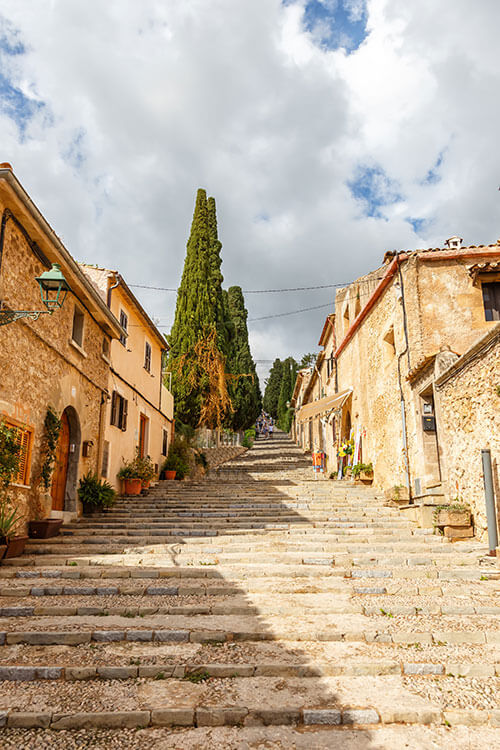
During the ascent, you will be accompanied by hundred-year-old cypress trees and the 14 three-metre-high crosses that flank the path, recalling the Calvary that, according to Christian tradition, Jesus Christ suffered. You will also find small souvenir shops that add a picturesque touch to the route.
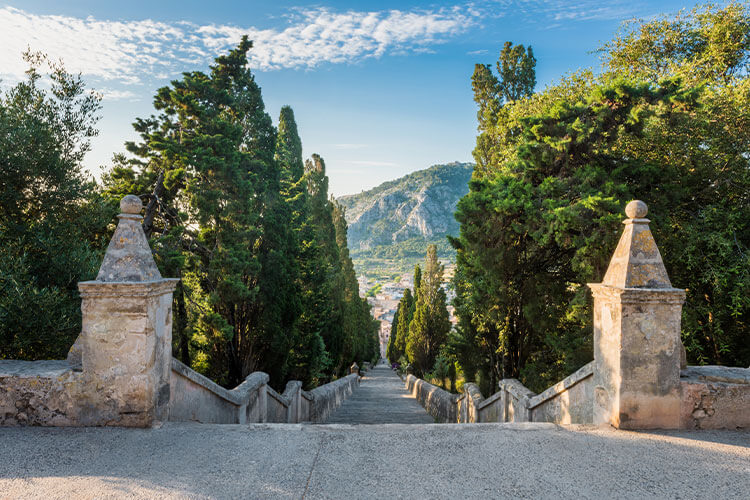
Once you reach the top, you will come across a charming 18th-century church, which was extensively restored in the 1960s. As well as enjoying the tranquillity of the place, you can marvel at the sculptures of Jesus Christ and the Virgin Mary which, according to legend, were discovered by fishermen in Cala de San Vicente. This small detail adds a mystical touch to the visit.
Plaza de la Almoina
The Plaza de la Almoina in Pollensa has not only witnessed important historical events but is also home to one of the town’s most prominent symbols: the rooster on its coat of arms.
In the past, this square was the heart of the community, where wheat and money were stored and distributed to the needy. However, the most memorable event occurred on a night in 1550, when the brave inhabitants of Pollensa defended their town against the Ottoman corsairs led by Dragut. Although clearly outnumbered, they managed to expel the invaders in an epic feat under the leadership of Joan Mas.
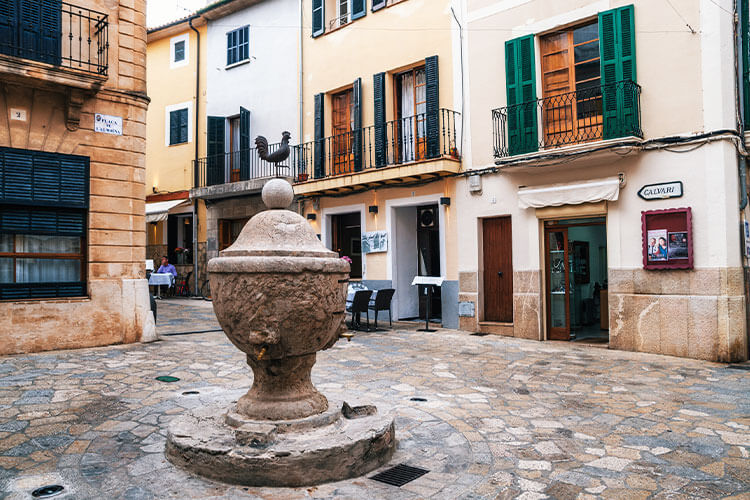
Nowadays, this story is commemorated every 2nd August with the famous Moors and Christians Fighting Simulation, a show that relives that heroic episode, coinciding with the festivities of the patron saint of Pollensa, the Virgin of the Angels.
Thus, the Plaza de la Almoina is not only a place to visit but also a place to remember the bravery and history of Pollensa.
Roman Bridge
The Pont Romà, with its two unequal arches and triangular spurs, crosses the Torrent de Sant Jordi, and its origin remains a real enigma.
Some say it was a Roman aqueduct, while others believe it is medieval. Although Pollensa was not founded as a town until the 13th century, this bridge is vital for the locals and is a historical jewel that you cannot miss.
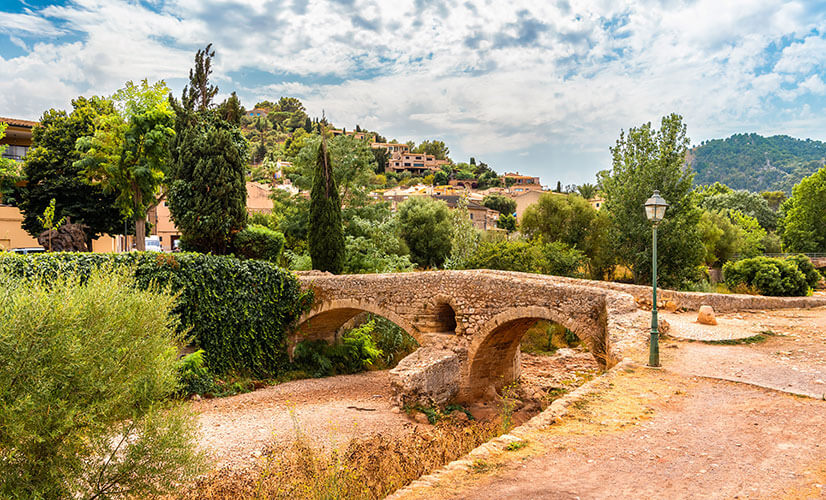
In addition to its functional importance, the bridge is a picturesque spot perfect for a photo and a leisurely stroll. So why not cross it and let your imagination run wild about its mysterious past?
Oratorio de Sant Jordi
Built in the 16th century, the Oratory of Sant Jordi stands on the spot where the brave militiamen of Pollensa used to gather to defend the coast from pirates.
This oratory, dedicated to Sant Jordi, patron saint of soldiers and knights, is not only a religious monument but also a symbol of the resistance and courage of the people of Pollensa.
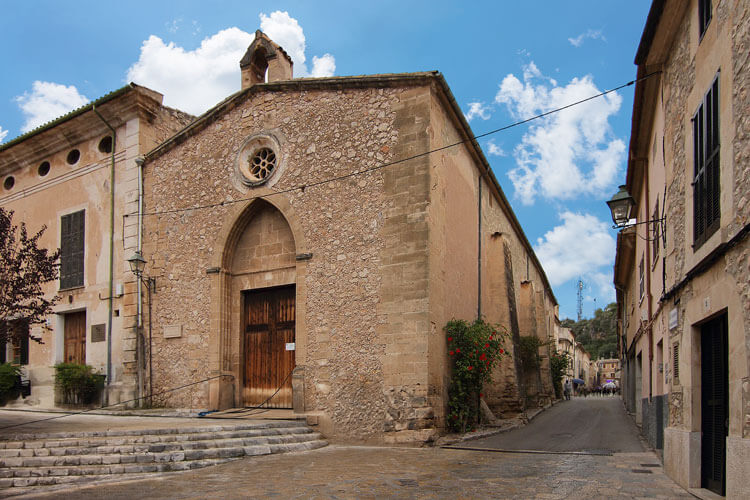
Today, with its impressive Baroque altarpiece and rich history, the Oratory of Sant Jordi is an essential place to discover the heritage and spirit of Pollensa. Don’t miss it!
Plaça Vella y Can Llobera
In the heart of Pollensa, right next to the imposing Church of Mare de Déu dels Àngels, is the historic Plaza Vieja.
This corner, with its medieval essence, was the epicentre of local life until the mid-19th century. Every 17th January, it hosts the famous Pi de Sant Antoni, where the brave attempt to climb a soaped pine tree in a tradition that fills the square with laughter and adrenaline.
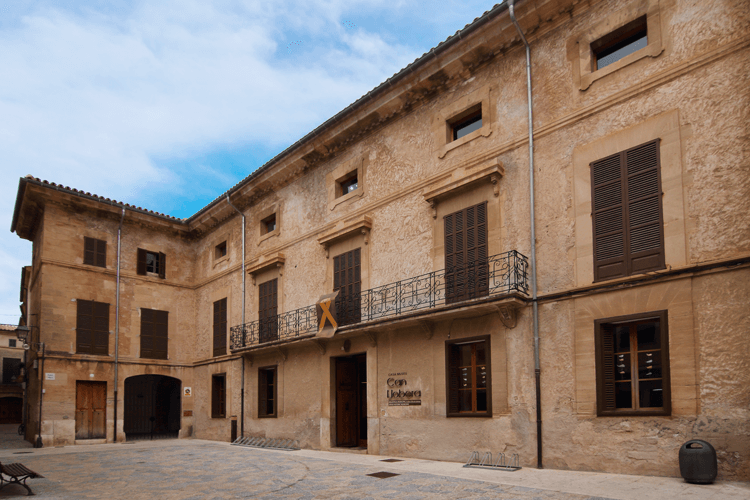
A few steps away, the majestic manor house of Can Llobera stands out. Built in the 16th century, it now houses the municipal library. This building has witnessed history, with its impressive imperial staircase making you feel part of a historical novel.
Hiking in Pollensa
Pollensa is a paradise for hikers due to its proximity to the Tramuntana mountains, offering a myriad of routes with spectacular views to explore. If steep climbs aren’t your thing, don’t worry – there are two must-do hikes suitable for all levels.
Puig de Maria
One of the greatest rewards of visiting Puig de Maria is the panoramic views of the bays of Pollença and Alcúdia, the Tramuntana mountain range, and the Albufera de Pollença.
Additionally, the place has a special charm as it is steeped in local legends, such as the apparition of a carving of the Virgin Mary.
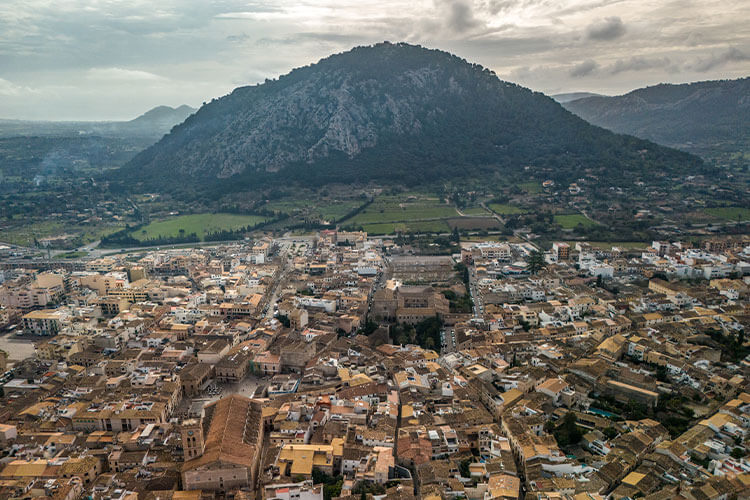
At the top of Puig de Maria is a sanctuary, located 330 metres above sea level, which offers not only breathtaking views but also a rich history that will transport you back to the 14th century. The sanctuary at Puig de Maria was built in 1348 as a plea to the Virgin Mary to protect the inhabitants from the Black Death.
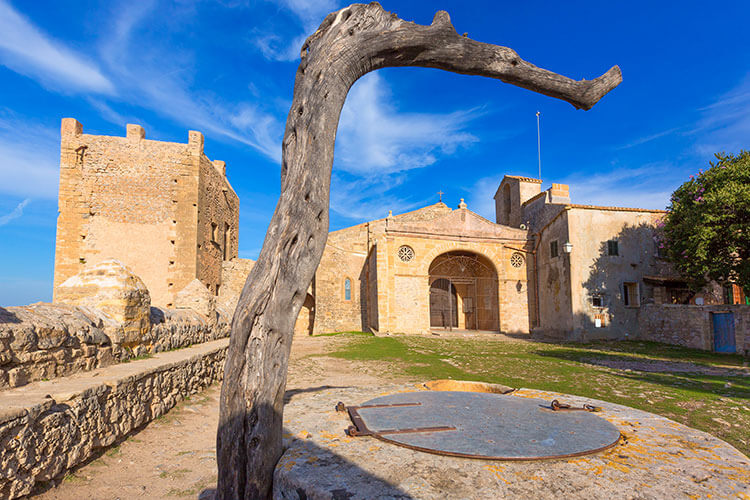
The initial chapel was completed in 1355, and soon after, in 1362, a community of nuns was established. During the 15th century, the monastery reached its peak, becoming a favourite destination for noble families who brought their daughters there.
Today, the monastery houses a guest house with 12 rooms available for visitors.
Formentor and Es Colomer Viewpoint
If you visit Pollensa, there is one place you can’t miss: the Es Colomer viewpoint. Located on the Formentor peninsula, this viewpoint rises more than 200 metres above sea level, offering spectacular views of the Tramuntana mountain range and the vast Mediterranean.
Upon arrival, you will be greeted by a monument dedicated to Antonio Parietti Coll, the visionary engineer responsible for the winding road that leads you to this magical spot. The Es Colomer viewpoint is especially famous for its breathtaking sunsets.
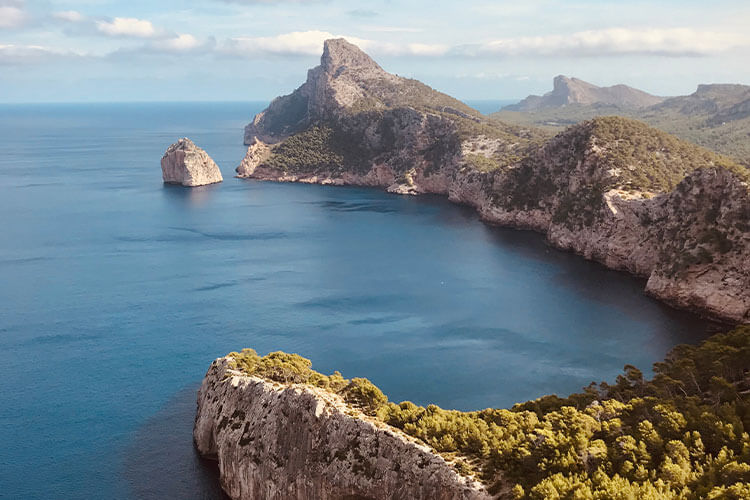
From this lookout, you can admire the islet of Colomer, an icon of the wild coast of the Tramuntana mountain range.
If you love hiking, you are in luck. From this viewpoint, there are routes that will take you to the historic watchtower of Albercuix, an old watchtower that offers another impressive perspective of the Mallorcan landscape.
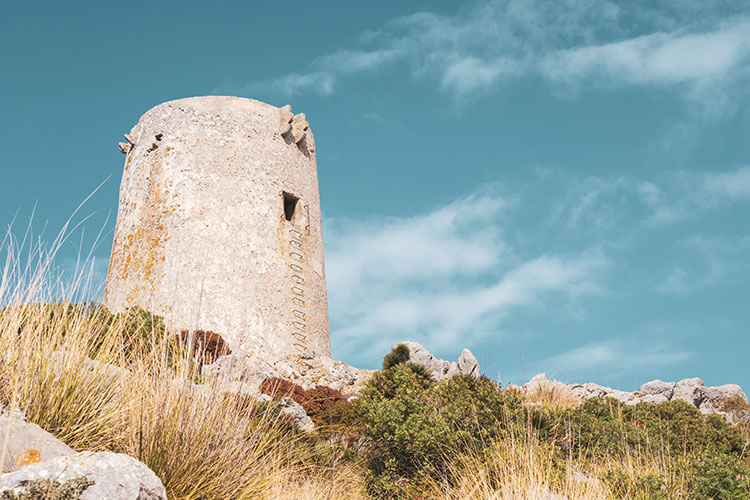
The Es Colomer viewpoint is not just a panoramic lookout; it is a visual and emotional experience that will connect you deeply with Mallorca’s nature.
Cycling en Pollensa
For all two-wheel enthusiasts, the excellent news is that Pollensa is a cyclist’s paradise. Many routes start from here, offering various levels of difficulty and excellent surface conditions, but above all, views that will really take your breath away—so be prepared for some intensive cycling. You’ll find various proposals for different skill levels.
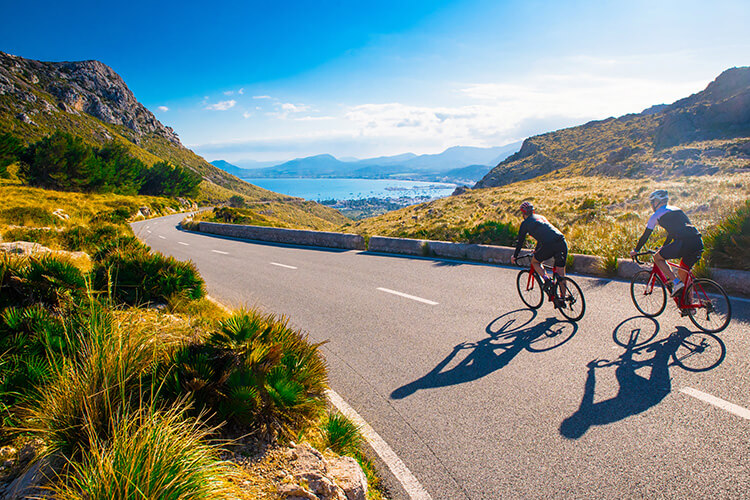
From beginners to the most experienced riders, every pedal stroke here turns into an adventure. The routes are distinguished not only by their variety and excellent conditions but also by the breathtaking views they offer. Be warned: more than once, you’ll find yourself breathless—and not just from the effort!
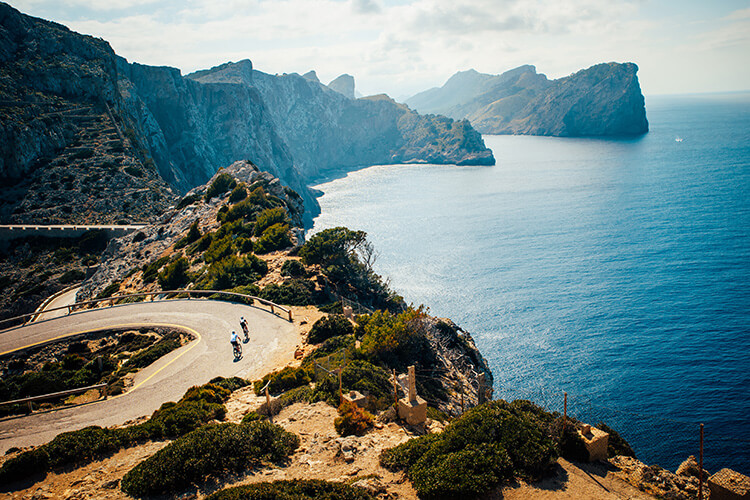
And if you’re ready to plan your first adventure, we invite you to check out our post on the best routes in the Pollensa area.
Beaches in the Pollensa Area
Pollensa is not only known for its historical charm but also for its stunning beaches, each with its own unique appeal and character. From expansive golden sands to secluded pebble coves, Pollensa offers endless options for sun and sea lovers. Below, we introduce you to some of the best beaches in the region, where you can enjoy warm sands, crystal-clear waters, and a perfect Mediterranean atmosphere.
Playa de Puerto de Pollensa
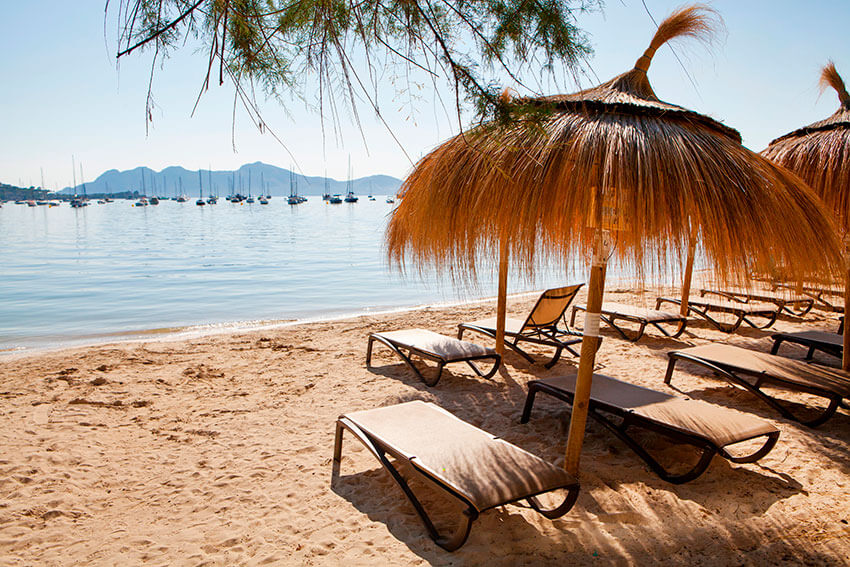
Imagine a beach with fine white sand, warm and calm waters, and numerous beach bars where you can enjoy a refreshing drink. That’s Playa de Puerto de Pollensa, perfect for spending the day relaxing, swimming, and soaking up the sun.
Playa de Formentor
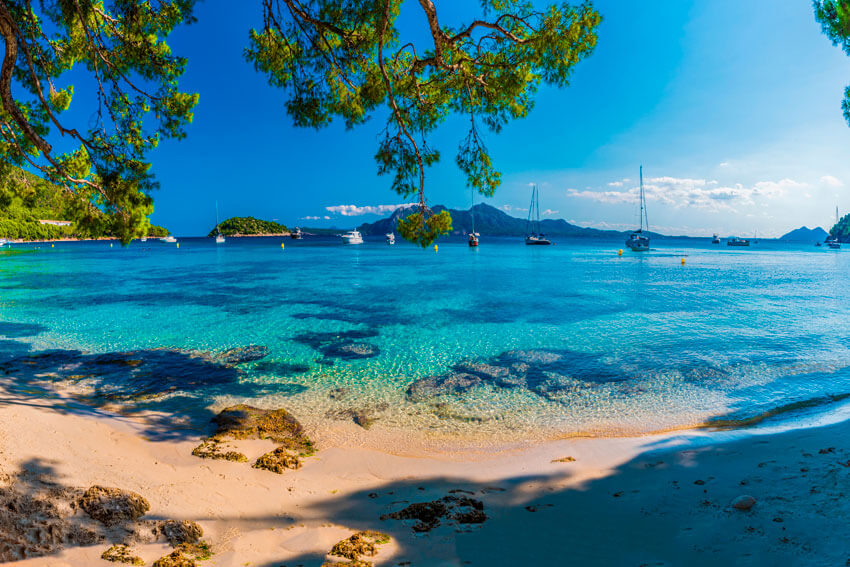
Also known as Cala Pi, this exclusive spot is possibly the most beautiful on the island. This kilometre of white sand and turquoise waters, surrounded by pine trees on the Formentor peninsula, is a dream destination.
Cala Sant Vicenç
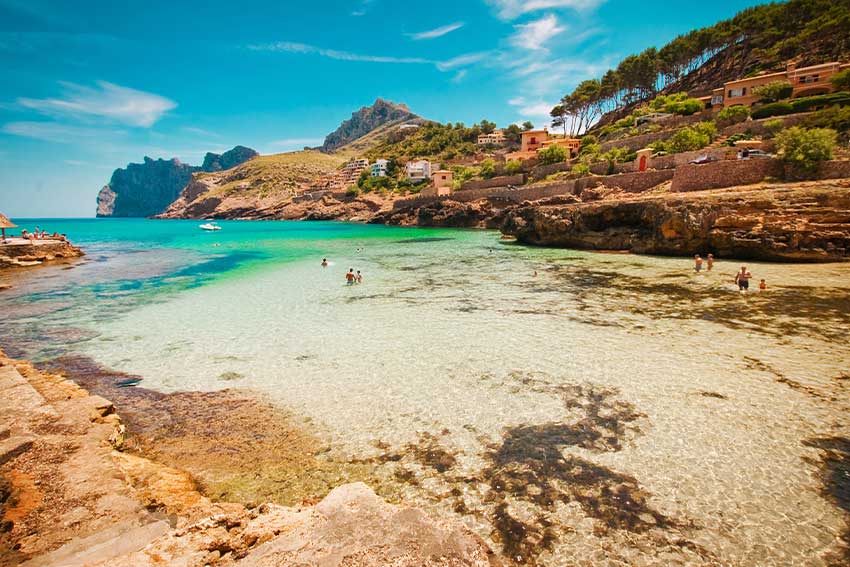
A small resort hidden in the mountains a few kilometres from Pollensa, is composed of four unique coves:
- Cala Barques: The widest, perfect for swimming.
- Cala Clara: Small and serene, ideal for relaxation.
- Cala Molins: Family-friendly and welcoming.
- Cala Carbó: The most inaccessible, but its beauty rewards the effort.
Cala Bóquer
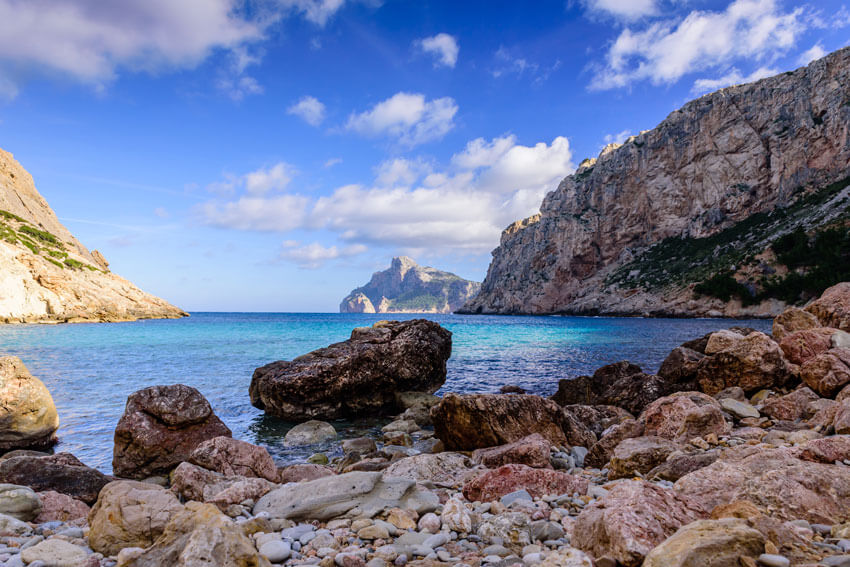
If you’re looking for a more adventurous experience, Cala Boquer is your destination. Situated at the end of the Boquer Valley, this pebble beach offers spectacular views of the coast and the sea. The trail to the cove is a perfect excursion to enjoy with the family.
Restaurants in Pollensa
Pollensa is a destination that will captivate you not only with its natural beauty but also with its rich gastronomic offerings. If you’re a lover of good food, particularly Mediterranean-style tapas, you’re in the perfect place.

Eenjoy an exceptional culinary experience, where you can delight yourself with a wide variety of tasty Mediterranean tapas, made with top quality local products, in a friendly and relaxed atmosphere in the heart of Pollença.
In the heart of Pollensa, just a few metres from the Plaza Mayor, you’ll find Mon Restaurant, a spot that offers delicious Mediterranean dishes and tapas made with fresh local produce.
So, take a break from your explorations and treat yourself to a feast of Mediterranean tapas. Enjoy your meal!
Where to stay in Pollensa?
Pollensa, that charming corner of Mallorca, not only captivates with its dreamy landscapes and relaxed atmosphere but also with a variety of accommodation that cater to all tastes and budgets. Let’s take a look at the best options.
Charming Hotels
If luxury and comfort are your preferences, Pollensa has a selection of boutique hotels that will make you feel at home, but with that special touch that only a holiday can offer. Our special recommendation is a four-star hotel with a beautiful rooftop and charming rooms located in the heart of Pollensa: the Mon Boutique Hotel.
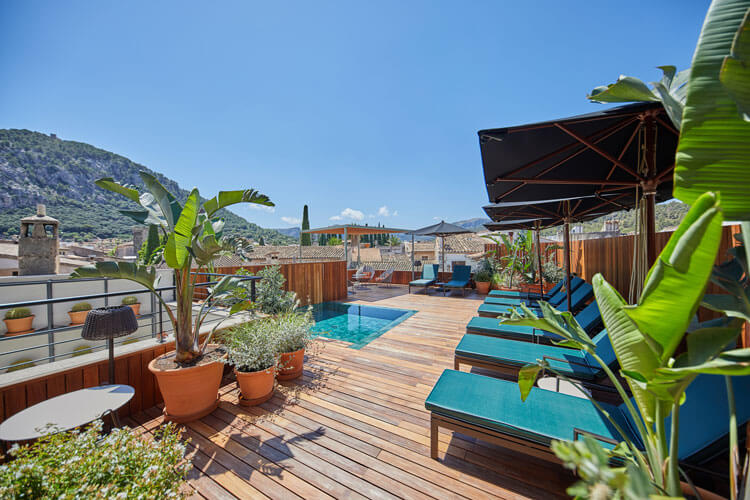
The Mon Boutique Hotel promises an unforgettable visit to Mallorca thanks to its style, comfort, and exceptional service.
Villas and Houses
For those who prefer a more authentic experience close to nature, the villas and houses in Pollensa are the perfect choice. With all the comforts of home and the freedom of your own space, you can enjoy a tailored holiday. Cook your own meals, organize barbecues on the terrace, or simply relax in your private pool.
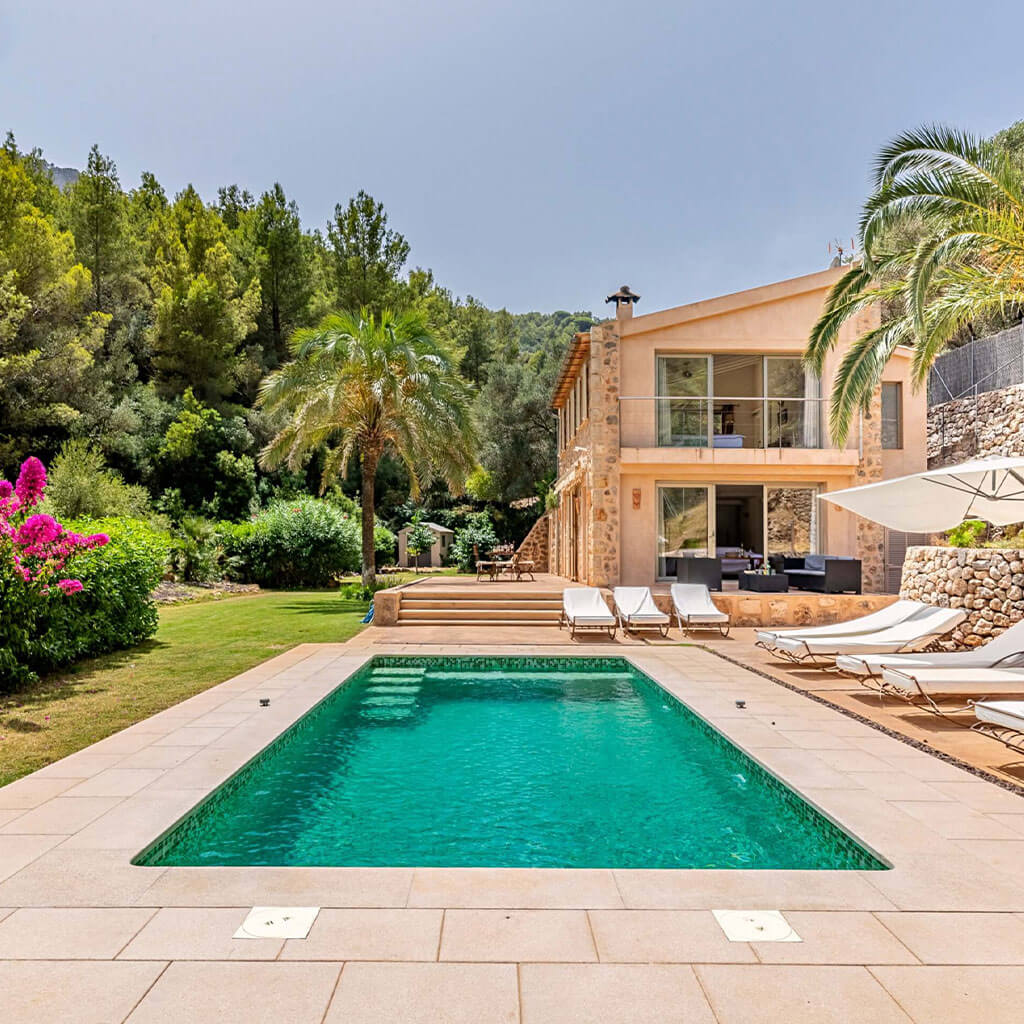
Sealand Villas offers unique experiences that combine luxury, comfort, and the authentic beauty of Mallorca. Booking with Sealand Villas is an invitation to enjoy a dream holiday.
Our recommendation for a secure holiday rental in Pollensa is Sealand Villas, a company with nearly 30 years of experience offering beautiful villas in the most picturesque locations in the area.
Summary
Pollensa, a picturesque town in the north of Mallorca, is the perfect destination for a peaceful holiday, far from the large resorts. Here, the serene atmosphere of a Mediterranean village blends with the fragrances of pine trees and the sea, sunny days, dazzling beaches, and the majestic mountains of the Sierra de Tramuntana, creating an experience for all the senses. It is an ideal place for those seeking a balance of nature, history, culture, fun, and delicious flavours. If you haven’t visited Pollensa yet, believe us, you need to change that!



Leave a Reply